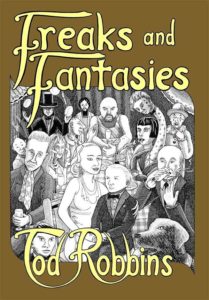 By TOD ROBBINS (Ramble House; 2007)
By TOD ROBBINS (Ramble House; 2007)
During the early 1900’s Tod Robbins (1888-1949) was a major horror writer, with several well-received novels (MYSTERIOUS MARTIN, THE UNHOLY THREE), poems and short stories to his credit. These days Robbins’s work has been largely—and I think unjustly—forgotten but for his 1923 novella “Spurs”, which inspired Tod Browning’s notorious FREAKS (1932).
Browning’s film, for those who don’t know, was the macabre account of a female trapeze artist who, together with her strongman boyfriend, plots to bilk a love-struck dwarf out of his life savings and then murder him. But the dwarf, with help from his fellow circus freaks, learns of the woman’s plans, leading to a horrific climax in which the freaks collectively murder the bitch.
“Spurs”, the third story of the present collection, has much in common with FREAKS but parts ways in its final third, wherein the spurs of the title come into play in shocking fashion. There’s also the fact that the band of circus freaks here, unlike the film’s all-for-one contingent, are a bickering lot perpetually at odds with one another—and the finale is even more hopeless and grotesque than that of FREAKS. It was “Spurs” that stoked my interest in FREAKS AND FANTASIES, and, I’m guessing, that of the publishers as well. It’s easily the most resonant tale of the collection, and very likely of Robbins’ entire ouvre.
As for FREAKS AND FANTASIES, it’s the first Robbins publication in over sixty years, and for that reason alone deserves a look. The fourteen stories collected here are for the most part solid, above-average examples of old school horror—and by old school I don’t mean the type of stately, suggestive blather that supposedly typified the genre back in olden times. If this collection proves anything, it’s that the scary stories of old were in their own way every bit as twisted as those of today.
If this collection proves anything, it’s that the scary stories of old were in their own way every bit as twisted as those of today.
While there’s little in the way of gore and slime in Robbins’ writing, there is a disquieting concentration on murder, madness and sleaze. Sure, his tales are well written and even classy, with some nicely poetic turns of phrase here and there, but don’t be fooled: these are bleak accounts with little in the way of morals or redemption. Their charms are adequately summed up by a quote from Robbins himself, included in Chris Mikul’s biographical introduction: “Have you ever witnessed an accident in the street? Hundreds collect in a moment. They are drawn there by that morbid streak in humanity, that overmastering desire to feast one’s eyes on gruesome details. Such a sensation will be gratified in my stories.”
While there’s little in the way of gore and slime in Robbins’ writing, there is a disquieting concentration on murder, madness and sleaze.
Included is the unforgettable “Who Wants A Green Bottle?” containing one of the more original conceptions of Hell I’ve encountered: a region of the deceased person’s house which the soul enters by literally climbing out of its host body and passing through a tiny hole in the nearest wall. “The Bibulous Baby” features a man who experiences time in reverse order from everybody else, starting out as an old man and “growing” into an infant. In “Wild Wullie the Waster” two warring men make peace in the afterlife, only to continue their rivalry by possessing the bodies of two rosy-cheeked billiard players. The unfortunate protagonist of “Toys of Fate” actually meets Fate, who turns out to be an old man with a sadistic streak. And in the marrow-chilling “The Confession” we’re privy to the first person thoughts of a condemned murderer who recounts his meeting with a killer even more deranged and methodical than himself: a judge!
Not all the stories worked for me. I found the novella-length “The Whimpus”, about a race of mermaid-like fish women, uninspiring. In contrast to the other tales, Robbins in this one tries for a more-or-less straightforward adventure narrative, a form that doesn’t suit him. Ditto the lighthearted whimsy of the interrelated Irish-flavored fantasies “A Bit of a Banshee” and “The Son of Shaemas O’Shea”, which came off stilted and self indulgent.
Other stories are lessened by the simple fact that they haven’t dated particularly well. That’s the case with “Silent, White and Beautiful”, whose concept of a homicidal madman who creates sculptures out of his victims might have seemed novel back in 1918, but not anymore. Then there’s “Cock-Crow Inn”, with its hanged criminal who disappears from the gallows—and shortly thereafter a pasty man turns up in the area with supernatural powers. Try and guess the “twist”…
For the most part, though, these are terrific stories penned by a writer of real skill.
For the most part, though, these are terrific stories penned by a writer of real skill. The best of them—“Who Wants A Green Bottle?”, “The Confession” and of course “Spurs”—can stand with most modern horror tales, as can the collection overall. It’s available from the independent publisher Ramble House, who can usually always be counted on to refurbish obscure and interesting publications from our distant past. FREAKS AND FANTASIES is a stellar example—get it at www.ramblehouse.com
